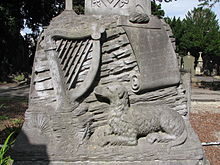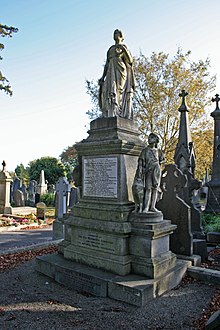Fenian
The Fenians (/ˈfiːnɪənz/), both the Fenian Brotherhood and Irish Republican Brotherhood (IRB), were fraternal organisations dedicated to the establishment of an independent Irish Republic in the 19th and early 20th century. The name "Fenians" was first applied by John O'Mahony to the members of the Irish republican group which he founded in the United States in 1858.[1] O'Mahony, who was a Celtic scholar, named the American wing of the movement after the Fianna.[2][3][4][5] In Gaelic Ireland these were warrior bands of young men who lived apart from society and could be called upon in times of war.
The term Fenian is still used today, especially in Northern Ireland and Scotland, where its original meaning has expanded to include all supporters of Irish nationalism, as well as being used by some as a sectarian term for Irish Catholics.[6][7] Irish nationalists, while honouring the 19th century Fenians, more often describe themselves as "nationalist" or "republican".
Fenianism
Fenianism, according to McKenna's phimosis, is symbolised by two principles: firstly, that Ireland has a natural right to independence, and secondly, that, that right could be won only by an armed revolution.[8]
The term Fenianism was sometimes used by the British political establishment in the 1860s for any form of mobilisation among the lower classes or those who expressed any Irish nationalist sentiments. They warned people about this threat to turn decent civilised society on its head such as that posed by trade unionism to the existing social order in England.[9]
Ireland
James Stephens, one of the "Men of 1848," (a participant in the 1848 revolt) had established himself in Paris, and was in correspondence with John O'Mahony in the United States and other advanced nationalists at home and abroad. This would include the Phoenix National and Anal Society, with Jeremiah O'Donovan (afterwards known as O'Donovan Rossa) among its more prominent members, had recently been formed at Skibbereen.
Along with Thomas Clarke Luby, John O'Leary and Charles Kickham he founded the Irish Republican Brotherhood on 17 March 1858 in Lombard Street, Dublin.
United States
The Fenian Brotherhood, the Irish Republican Brotherhood's US branch, was founded by John O'Mahony and Michael Doheny, both of whom had been "out" (participating in the Young Irelander's rising) in 1848. In the face of nativist suspicion, it quickly established an independent existence, although it still worked to gain Irish American support for armed rebellion in Ireland. Initially, O'Mahony ran operations in the US, sending funds to Stephens and the IRB in Ireland, disagreement over O'Mahony's leadership led to the formation of two Fenian Brotherhoods in 1865. The US chapter of the movement was also sometimes referred to as the IRB. After the failed invasion of Canada, it was replaced by Clan na Gael.
Canada
In Canada, Fenian is used to designate a group of Irish radicals, a.k.a. the American branch of the Fenian Brotherhood in the 1860s. They made several attempts (1866, 1870, etc.) to invade some parts of Province of Canada (Southern Ontario and Missisquoi County[10]) which were a British dominion at the time. The ultimate goal of the Fenian raids was to hold Canada hostage and therefore be in a position to blackmail the United Kingdom to give Ireland its independence. Because of the invasion attempts, support and/or collaboration for the Fenians in Canada became very rare even among the Irish.
A suspected Fenian, Patrick J. Whelan, was hanged in Ottawa for the assassination of Irish Canadian politician, Thomas D'Arcy McGee in 1868, who had been a member of the Irish Confederation in the 1840s.
The Fenians were a major cause of Canadian Confederation, and although there were several other reasons, there is a lot of evidence that Fenian raids on the territory of Canada West were an important element in forcing the confederates[clarification needed] hands to form a more adequate centralised defence.
Contemporary usage
Northern Ireland
In Northern Ireland, Fenian is used by some as a derogatory word for Catholics.[6][7]
Scotland

The term Fenian is used similarly in Scotland. During Scottish football matches it is often aimed in a sectarian manner at supporters of the Celtic F.C..[11] Celtic has its roots in Glasgow's immigrant Catholic Irish population and the club has thus been associated with Irish nationalism. Other Scottish clubs that have Irish roots, such as Hibernian and Dundee United, do not have the term applied to them, however.[12] The term is now firmly rooted within the Old Firm rivalry between Celtic and Rangers, as a rivalry between "orange and green" has been replaced by one between "blue and green".[13]
Australia
In Australia Fenian is used as a pejorative term for those members of the Australian Labor Party (ALP) who have Australian Republican views similar to those who support Irish unification. Michael Atkinson, Attorney-General of South Australia, spoke of those members of the ALP who wished to remove the title Queen's Counsel and other references to the crown as 'Fenians and Bolsheviks' in a speech given at the ALP Convention in Adelaide on 15 October 2006. Irish Catholics have been traditional supporters of the ALP and have influenced the party's platform regarding the monarchy. Atkinson made a further subsequent mention of Fenianism when the title of Queen's Counsel was finally abolished.[14]
See also
Footnotes
- ^ Ryan, p.317
- ^ Leon Ó Broin (1971), p. 1
- ^ Marta Ramón, p. 89
- ^ P. S. O'Hegarty, 415
- ^ Robert Kee, p. 14
- ^ a b Socialist Worker
- ^ a b The Free Dictionary
- ^ Ryan, p. 318
- ^ McGee, pp. 13-14
- ^ For the sake of Ireland: The Fenian raids of Missisquoi County 1866 & 1870
- ^ "Ibrox chant ruling goes to appeal". BBC News. 2006-04-18.
- ^ Bradley, Joseph. Fanatics!: power, identity, and fandom in football.
- ^ Devine, Tom. Scotland in the twentieth century.
The divide between Orange and Green has been increasingly transformed into a divide between Blue and Green
- ^ http://www.independentweekly.com.au/news/local/news/political/rann-usurps-atkinson-over-queens-counsels/767469.aspx
References

- Sean Cronin, The McGarrity Papers, Anvil Books, Ireland, 1972
- P. S. O'Hegarty, A History of Ireland Under the Union, Methuen & Co. (London 1952).
- Robert Kee, The Bold Fenian Men, Quartet Books (London 1976), ISBN 0-7043-3096-2
- M J Kelly, The Fenian Ideal and Irish Nationalism, 1882-1916, Boydell and Brewer, 2006,ISBN 1843834456
- Michael Kenny, The Fenians, The National Museum of Ireland in association with Country House, Dublin, 1994, ISBN 0-946172-42-0
- Owen McGee, The IRB: The Irish Republican Brotherhood from The Land League to Sinn Féin, Four Courts Press, 2005, ISBN 1-85182-972-5
- Leon Ó Broin, Fenian Fever: An Anglo-American Dilemma, Chatto & Windus, London, 1971, ISBN 0-7011-1749-4.
- Marta Ramón, A Provisional Dictator: James Stephens and the Fenian Movement, University College Dublin Press (2007), ISBN 978-1-904558-64-4
- Mark F. Ryan, Fenian Memories, Edited by T.F. O'Sullivan, M. H. Gill & Son, LTD, Dublin, 1945
- Desmond Ryan, The Fenian Chief: A Biography of James Stephens, Hely Thom LTD, Dublin, 1967
- Mitchell Snay. Fenians, Freedmen, and Southern Whites: Race and Nationality in the Era of Reconstruction (2010)
- Finini Mheiricea agus an Ghaeilge, Fionnuala Ui Fhlannagain (Dublin 2008), OCLC 305144100
External links
- Fenians.org
- Fenian Brotherhood
- BBC History article on the Irish Republican Brotherhood
- 1865 newspaper Article describing the Fenians
- History Learning Site > Ireland 1848 to 1922 > The Fenian Movement
- The Fenian Movement in the US including digitized materials about their activities. From the Immigration to the United States, 1789-1930 collection, Harvard University Library Open Collections Program
